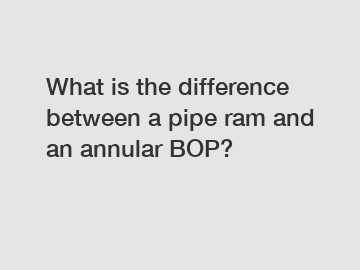What is the difference between a pipe ram and an annular BOP?
What is the difference between a pipe ram and an annular BOP?
When it comes to Blowout Preventer (BOP) systems, two commonly used components are pipe rams and annular BOPs. These devices play a crucial role in ensuring the safety and integrity of oil and gas wells during drilling and production operations. While both pipe rams and annular BOPs serve the same purpose of sealing the wellbore, there are distinct differences in their mechanisms and applications.
Pipe rams are essentially a set of hydraulically operated steel plates that are designed to close around the drill pipe or tubing, effectively sealing the wellbore. Their main function is to prevent the uncontrolled release of fluids and gases during well interventions, such as tripping pipe or performing maintenance activities. Pipe rams are well-suited for sealing around a specific size and shape of pipe or tubing, offering a reliable barrier against wellbore pressure.

On the other hand, annular BOPs feature a flexible elastomeric seal that expands around various sizes of drill pipe or tubulars. Unlike pipe rams, annular BOPs provide a versatile sealing solution for different pipe diameters. By applying pressure to the elastomeric seal, annular BOPs create a complete and effective barrier between the inside of the wellbore and the external environment.
The choice between using pipe rams or annular BOPs depends on the specific well conditions, drilling operations, and regulatory requirements. Pipe rams are often preferred in situations where there is a consistent use of standard pipe sizes and wellbore conditions are relatively stable. They offer a high degree of reliability and wellbore integrity, reducing the risk of blowouts and uncontrolled releases.
On the other hand, annular BOPs are particularly useful in drilling operations that involve multiple pipe sizes or when variations in wellbore conditions are expected. Their ability to adapt to different pipe sizes provides flexibility and efficiency in sealing the wellbore, minimizing the need for changing out pipe rams for different sizes. Additionally, annular BOPs can accommodate larger tools or wirelines for interventions in the wellbore, enhancing the operational capabilities of the drilling system.
The difference between pipe rams and annular BOPs has significant implications for well control and safety during drilling and production operations. The choice of the appropriate BOP component ensures that the wellbore is effectively sealed, reducing the risk of blowouts and uncontrolled releases. It is essential to consider wellbore conditions, pipe sizes, and operational requirements when selecting between pipe rams and annular BOPs. Proper installation, maintenance, and testing of these BOP components are fundamental to ensuring their functionality and reliability in preventing well control incidents.
In conclusion, while both pipe rams and annular BOPs serve the purpose of sealing the wellbore, they have distinct differences in terms of mechanism and application. Pipe rams offer a reliable sealing solution for specific pipe sizes, while annular BOPs provide versatility in sealing various pipe diameters. The selection of the appropriate BOP component is crucial for maintaining wellbore integrity and ensuring the safety of drilling and production operations.
If you want to learn more, please visit our website 26 3/4”ram bop, pipe ram bop, bop control unit manufacturer.


